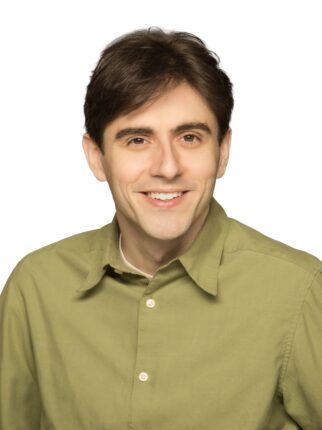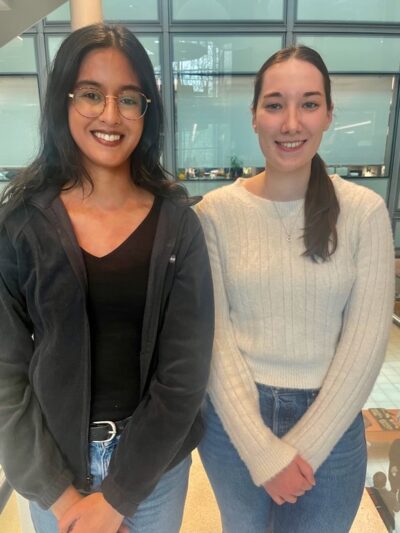

Joseph Subotnik
Contact:
Joseph Subotnik
David B. Jones Professor of Chemistry
[email protected]
Frick Laboratory, 329
609-258-7349
Faculty Assistant:
Pattie Faranetta
Faculty / Grants Assistant
[email protected]
Frick Laboratory, 228
609-258-5202
Research Focus
Our laboratory studies the flow of energy between different forms of light and matter. For example, we are interested in how a photon carries energy to excite an electron in a tree’s leaf, which then leads to a chemical reaction where new chemical bonds are made, followed by a spin flip (which removes a bit more energy) and then finally the release of all the remaining energy into the thermal motion of the nuclei. At each step along the process, energy takes different forms. Two unifying principles are: (i) the total energy is always conserved (which we can verify with dynamics) and (ii) the total energy inevitably is broken apart into smaller and smaller chunks of energy (which is consistent with the second law of thermodynamics). The goal of our research program is to quantify all of the effects above and make contact with a vast array of modern experiments in catalysis, electrochemistry, photochemistry, and energy science.
Chemical Dynamics: Beyond Marcus theory, our group is very interested in modeling general nonadiabatic phenomena, including electron and energy transfer, electronic relaxation, and molecular conduction with vibrations. To that end, we have systematically analyzed the origins of Tully’s fewest switches surface hopping algorithm (FSSH) algorithm. Surface hopping began as a guessed algorithm; originally Preston and Tully proposed rules for moving nuclei between different potential energy surfaces when one encounters a crossing. Later, Tully proposed a fewest switches surface hopping (FSSH) algorithm with a continuous probability to hop based on the time step. In our research group, we are interested in understanding the foundations of surface hopping, going back to the Schrodinger equation, finding tractable means of including decoherence and extending the method to include spin flipping.
Electronic Structure: From the perspective of electronic structure theory, modeling electron and energy transfer boils down to generating accurate electronic energies, accurate electronic couplings, and potentially accurate embeddings of the relevant electronic states in continua (as relevant for electrochemical dynamics; see below). One of the difficulties we face in generating an electronic structure description is that there are inevitably many curve crossings, so that perturbation theory breaks down and we require multi-reference calculations. Our laboratory is interested in generating cheap and dirty electronic structure approaches that are relevant for dynamics, as well generating the proper electronic structure calculations in a moving basis (which is one means of going beyond the Born-Oppenheimer approximation).
Electrochemistry: When molecules approach metal surfaces, the normal rules of nonadiabatic dynamics become unclear. Now, rather than just a handful of electronic states, there is a continuum of electronic states. As such, standard surface hopping with a set of (infinitely many) adiabatic states is unrealistic. Instead, two different approaches have been proposed. (i) One can work with a surface-hopping perspective, which can be derived from Redfield theory and is valid in the limit of our sphere electrochemistry. (2) One can work with a ground-state mean-field perspective, whereby electronic transitions become a form of “electronic friction”. The picture of electronic friction is an old (but slightly confusing!) concept that should be valid in the limit of our sphere electrochemistry. We are interested in building a theory that interpolates between these two limits and is practical; such a theory will also clearly tie into the electronic structure approaches above.
Light-Matter Interactions: In recent years, there has been an explosion of interesting in strong light-matter interactions. On the one hand, within the field of polaritonics, one considers a set of molecules interacting collectively with a small number of radiation modes inside of a cavity and one questions: If molecules interact collectively with one radiation mode and this interaction leads to a splitting of the radiation mode as observed spectroscopically through a Rabi splitting, does that mean that there will be a collective effect on the molecular motion? On the other hand, within the field of plasmonics, one is interested in understanding what is the effect of extremely large electromagnetic forces (as generated by a metal surface) on the chemical dynamics? We aim to answer some of these questions and go beyond the limit of continuous wave Floquet theory.
Spin Physics: Spin-flips and intersystem crossing are a very important part of electronic relaxation. Moreover, recent experiments have demonstrated that electronic relaxation in chiral environments is often very spin-dependent, which is highlighted in the so-called Chiral Induced Spin Selectivity (CISS) effect. However, as mentioned above, understanding exactly how spin flips are tied to electronic relaxtation and nuclear motion remains a challenge for modern theory, especially if one seeks ab initio methods. One key impediment is that, although a fully quantum Born-Oppenheimer approach conserves angular momentum, we showed in 2023 that a classical Born-Oppenheimer approach does not conserve angular momentum. Developing new nonadiabatic methods that do conserve angular momentum is a key goal for us and for the field, because a merger of spintronics with chemical dynamics would allow for very new magnetic field induced applications.
Honors
2020: APS fellow
2019: National Blavatnik Finalist
2018: National Blavatnik Finalist
2016: Guggenheim Fellowship
2015: Camille and Henry Dreyfus Teacher Scholar Award
2015: Journal of Physical Chemistry B Lectureship
2013: Research Corporation Cottrell Scholar
2012: Packard Fellowship for Science and Engineering
2012: Presidential Early Career Award for Science and Engineering (PECASE)
2012: NSF CAREER Award
2012: Alfred P. Sloan Research Fellow
2012: ACS Hewlett-Packard Outstanding Junior Faculty Award
2011: Air Force Young Investigator
2009: ACS Postdoctoral Highlighted Fellow in Physical Chemistry
2007-2009: NSF International Postdoctoral Fellow, Tel-Aviv University
2001-2006: John and Fannie Hertz Foundation Fellowship in Applied Sciences
Selected Publications
J.E. Subotnik, “Chiral molecules to transmit electron spin,” Science 382, 160-161. (2023); https://doi.org/10.1126/science.adk5634
T.E. Li, A. Nitzan, J.E. Subotnik, “Energy-efficient pathway for selectively exciting solute molecules to high vibrational states via solvent vibration-polariton pumping,” Nature Communications 13, 1-8 (2022); https://doi.org/10.1038/s41467-022-31703-8
X. Bian, Y. Wu, J. Rawlinson, R. G. Littlejohn, and J. E. Subotnik, “Modeling Spin-Dependent Nonadiabatic Dynamics with Electronic Degeneracy: A Phase-Space Surface-Hopping Method,” J. Phys. Chem. Lett., 13, 7398–7404 (2022); https://doi.org/10.1021/acs.jpclett.2c01802
T.E. Li, B Cui, JE Subotnik, A Nitzan, “Molecular Polaritonics: Chemical Dynamics Under Strong Light–Matter Coupling,” Ann. Rev. Phys. Chem. 73 , 43 (2021); https://doi.org/10.1146/annurev-physchem-090519-042621
H.H. Teh, W Dou, JE Subotnik, “Antisymmetric Berry frictional force at equilibrium in the presence of spin-orbit coupling,” Phys. Rev. B 104, L201409 (2021); https://doi.org/10.1103/PhysRevB.104.L201409
X. Bian, Y. Wu, H.H. Teh, Z. Zhou, H.T. Chen, J.E. Subotnik, “Modeling nonadiabatic dynamics with degenerate electronic states, intersystem crossing, and spin separation: A key goal for chemical physics,” J. Chem. Phys. 154, 110901 (2021); http://doi.org/10.1063/5.0039371
Y. Wu, J.E. Subotnik, “Electronic spin separation induced by nuclear motion near conical intersections,” Nature Communications 12, 1-7 (2021); https://doi.org/10.1038/s41467-020-20831-8
T.E. Li, J.E. Subotnik, A. Nitzan, “Cavity molecular dynamics simulations of liquid water under vibrational ultrastrong coupling,” Proceedings of the National Academy of Sciences 117, 18324-18331, (2020); https://doi.org/10.1073/pnas.2009272117
W. Dou and J. E. Subotnik, “Feature Article: Nonadiabatic Molecular Dynamics at Metal Surfaces,” J. Phys. Chem. A, 124, 757-771 (2020); https://doi.org/10.1021/acs.jpca.9b10698
H. H. Teh and J. E. Subotnik, “The Simplest Possible Approach for Simulating S0−S1 Conical Intersections with DFT/TDDFT: Adding One Doubly Excited Configuration,” J. Phys. Chem. Lett., 10 , 3426 – 3432 (2019); https://pubs.acs.org/doi/10.1021/acs.jpclett.9b00981

